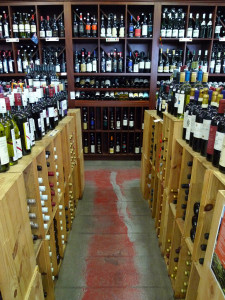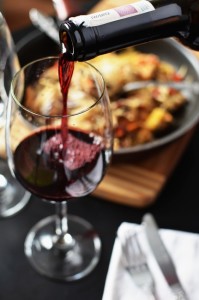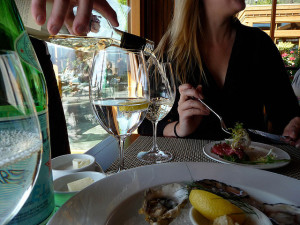As anyone who has ever stepped foot in a wine shop or glanced down the wine aisle in the grocery store can tell you, there is an inordinate amount of choices when it comes to the selection of wines available. Often, the sheer number of choices will

Photo courtesy Flickr user Ruth Hartnup
overwhelm many people to the point where they are reluctant to try anything new and they will just stick to what they know or skip the wine all together and purchase beer, cider, or spirits.
In the food industry, this fear or avoidance to trying new foods is called “food neophobia”, and has been extensively studied in academic circles, with the ultimate development of The Food Neophobia scale (i.e. just how reluctant or averse someone is to trying new foods). Food neophobics demonstrate tend to accept or like both familiar and unfamiliar food less than food neophilics, while food neophilicis tend to enjoy new foods positively. While there exists an extensive library of research on food neophobia and The Food Neophobia scale, there isn’t a comparable scale for wine, though it is known that there exists a population of individuals who are hesitant to try new wines.
While there isn’t a consensus in terms of where someone needs to fall on The Food Neophobia scale to actually be considered a true food neophobic person, the scale is frequently used for research and marketing purposes. Theoretically, the same could be done for a wine neophobia scale, if one were to exist. Using a wine neophobia scale could help wineries and marketers develop a more targeted advertising campaign to help increase sales while also helping those with an aversion to trying to wines break out of the cycle and open themselves up to the world of wine.
A new study, published in the journal Food Quality and Preference, aimed to develop a Wine Neophobia Scale based on

Photo courtesy Pexels
the existing Food Neophobia Scale, to use as a method for determining a population’s reluctance or acceptance of new wines, which could help improve advertising programs and ultimately sales.
Brief Methods
In order to develop the new Wine Neophobia Scale, the researchers took the Food Neophobia scale and simply changed the word “food” for the word “wine” in all of the questions. After this switch, the researchers decided to drop one of the questions, since after the switch to “wine” the question was no longer applicable (“Ethnic food looks too weird to eat” switched to “ethnic wine” doesn’t work, since “ethnic wine” isn’t considered to be a thing). This left a total of 9 questions out of an original 10.
To test the new Wine Neophobia Scale, 207 students and staff from two Universities in Adelaide, Australia were recruited and given the survey. After the test, it was determined that there was a second question that did not really work, which was ultimately removed to leave 8 questions (“I am very particular about the wines I will drink” was the question removed).
After the first test, a retest was performed using 471 wine consumers recruited via newspaper advertisements. 1 year later, a smaller subset of this group (159 of them) took the test again and were asked additional questions regarding their alcohol consumption behavior (using the “Exploratory Consumer Buying Behavior Scale”).
Finally, after the 2 tests and the retest, the developed Wine Neophobia Scale was then administered to 1000 wine drinkers in Australia that were recruited through a marketing agency. Participants were asked to complete the 8 question survey as well as questions about demographics online.
None of the participants were involved in more than one test (i.e. the people participating were different each time the survey was tested and retested).
Selected Results
- Statistical analysis revealed that only 8 of the 10 original questions from the Food Neophobia Scale could be used for the new Wine Neophobia scale.
- There was a statistical similarity between the Food Neophobia scale and the new Wine Neophobia scale, though they were not statistically equivalent.
- Comapring the results of the test and subsequent retest a year later, it was determined that the new Wine Neophobia Scale was both reliable and stable.
- The validity of the new Wine Neophobia Scale was confirmed using the additional wine consumption behavior questions asked.
- Neophobics and neophilics were determined by splitting the results up by quarters: those in the highest scoring quarter were labelled as “neophilics” and those in the lowest scoring quarter were labelled as “neophobics”. The remaining participants were considered “neither one nor the other”.
- Neophilics were found to be willing to try new wines.
- Neophobics often stuck to familiar brands and often drank the same kind of wine regularly.
- There were no gender differences in regards to the population of neophobics and neophilics (note: this is the same result that has been shown in food studies).
- Education level was negatively correlated with neophobia status (i.e. neophilics tended to be more educated than neophobics). (Note: this result has also been seen in food studies).
- 7% of neophilics possessed a tertiary education, while only 34.2% of neophobics had the same high level of education.
- Income was strong correlated with neophobia status.
- At income levels higher than AUD$100K, 33.5% were neophilics while 18.5% were neophobics.
Conclusions
This study created a reliable and stable alternative to the Food Neophobia Scale, dubbed the Wine Neophobia Scale. While the two tests were very similar, they were not statistically equivalent.
Two characteristics that the researchers noted were related to education and income. For education, the level of education a participant had was found to be negatively correlated with wine neophobia status. In other words, wine neophilics tended to

Photo courtesy Flickr user Kelowna09
have higher education levels than neophobics. The researchers surmised that this may be due to more educated individuals having greater access and exposure to new kinds of foods, which is the result that has been seen in the food studies. Additionally, someone’s willingness to try new wine has been shown to increase with experience, therefore those with greater education and experience are more likely to branch out and try new wines compared with someone with less knowledge and education.
For income, results showed that a greater proportion of those with income over AUD$100K were wine neophilics. The researchers postulated that those with higher incomes might be more likely to travel more often, thus being more exposed to a variety of different wines. Not all in the high income group were neophilics, however, indicating that there are other factors at play.
Since the Wine Neophobia Scale is a very new tool, a lot more research should be done in order to fully understand the information it is giving you and how that information may be used for marketing or other purposes. I’d like to see the study repeated in different parts of the world (this study just used Australian participants) as well as different age groups (i.e. Millennials versus Baby Boomers, etc).
Another area of research that was suggested by the researchers and that I agree would be interesting would be to see how an individual’s Wine Neophobia Scale score changes over time. If they are considered wine neophobic the first time they take the test, how does time and experience alter their scores over time? Is wine neophobia a trait that is retained over the years? Or does education and experience change this trait over time?
As more research is done, the Wine Neophobia Scale could be an important tool for wineries, wine shops, and other wine merchants to more accurately target their potential customer base.
What do you all think about the Wine Neophobia Scale? Feel free to leave any comments or questions you may have!

2 comments for “The Wine Neophobia Scale: A New Tool for Determining Wine Preferences and Purchase Behavior”